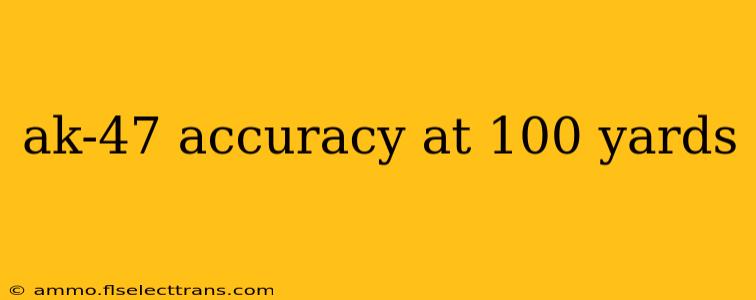The AK-47, a globally recognized symbol of military might, is often stereotyped as a crude, inaccurate weapon. While its design prioritizes reliability and ease of maintenance over pinpoint accuracy, understanding its capabilities at 100 yards requires a nuanced perspective. This article delves into the factors influencing AK-47 accuracy at this range, dispelling common myths and providing a realistic assessment.
Factors Affecting AK-47 Accuracy at 100 Yards
Several factors significantly impact the accuracy of an AK-47 at 100 yards:
1. The Rifle Itself: Manufacturing Variations and Condition
Not all AK-47s are created equal. Variations in manufacturing tolerances, the quality of components, and the overall condition of the rifle (wear and tear, maintenance history) directly affect its accuracy. A well-maintained, high-quality AK-47 will naturally outshoot a neglected, poorly manufactured example. Specific models and manufacturers also exhibit differing levels of inherent accuracy.
2. Ammunition: Caliber, Grain Weight, and Quality
Ammunition plays a crucial role. The type of ammunition used—specifically, the caliber (7.62x39mm is most common), grain weight of the bullet, and the quality of the manufacturing—all impact accuracy. Higher-quality ammunition with consistent powder charges and bullet construction will generally yield better results than cheaper, less consistent rounds.
3. The Shooter: Skill and Technique
Perhaps the most significant factor influencing accuracy is the shooter themselves. Proper shooting technique, including stance, grip, sight alignment, and trigger control, is paramount. A skilled shooter can significantly improve the AK-47's accuracy, while a novice may struggle to achieve consistent results even with a high-quality rifle and ammunition.
4. Environmental Conditions: Wind, Temperature, and Humidity
Environmental factors significantly impact bullet trajectory. Wind, in particular, can dramatically deflect bullets at 100 yards. Temperature and humidity also subtly affect the performance of the ammunition.
Realistic Expectations: Accuracy vs. Precision
It's important to distinguish between accuracy and precision. Accuracy refers to how close shots are to the target's center, while precision refers to how closely grouped the shots are. The AK-47, due to its design, generally exhibits higher precision than accuracy at longer ranges. This means shots may be clustered together, but not necessarily centered on the target.
At 100 yards, a skilled shooter using high-quality ammunition in a well-maintained rifle can expect to achieve groupings within a 4-6 inch radius under ideal conditions. However, this is a best-case scenario. In less-than-ideal conditions, or with less-skilled shooters, the groupings may be considerably larger.
Dispelling the Myths: Is the AK-47 Inherently Inaccurate?
The common perception of the AK-47 as inherently inaccurate is a simplification. While it's not designed for long-range precision shooting like some purpose-built sniper rifles, its accuracy at 100 yards is perfectly adequate for its intended purpose: close-quarters combat and intermediate-range engagements. With proper technique, ammunition, and maintenance, the AK-47 can be surprisingly accurate for its intended role.
Conclusion: Context is Key
The accuracy of an AK-47 at 100 yards is heavily context-dependent. Factors like the rifle's condition, ammunition quality, shooter skill, and environmental conditions all play crucial roles. While not a long-range precision instrument, with proper attention to detail, a skilled shooter can achieve respectable accuracy at this distance. Remember that the weapon's design priorities lie elsewhere, prioritizing reliability and ease of use over extreme long-range accuracy.

